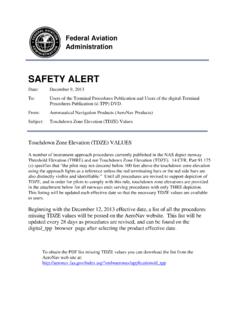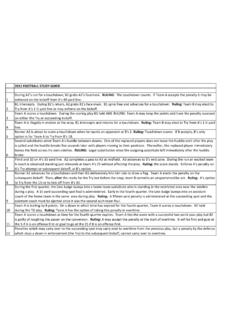Transcription of AC 91-79A - Mitigating the Risks of a Runway Overrun Upon ...
1 Department of Transportation Federal Aviation Administration Advisory Circular Subject: Mitigating the Risks of a Runway Overrun Upon Landing Date: 9/17/14 Initiated by: AFS-800 AC No: 91-79A Change: 1. PURPOSE. This advisory circular (AC) provides ways for pilots and airplane operators to identify, understand, and mitigate Risks associated with Runway overruns during the landing phase of flight. It also provides operators with detailed information that operators may use to develop company standard operating procedures (SOP) to mitigate those Risks .
2 2. AUDIENCE. This document provides guidance to pilots and flightcrews, airplane operators, certificate holders, program managers, training providers, pilot examiners, and other support personnel. Pilots, airplane operators, certificate holders, program managers, training centers, and other support personnel should adopt the recommended procedures found in this AC to enhance awareness of the Risks inherent during the landing phase of flight and the mitigations to employ to reduce the risk of a Runway landing Overrun . 3.
3 APPLICABILITY. The focus of the content of this AC is primarily on operations not covered by Safety Alerts for Operators (SAFO) 06012, Landing Performance Assessments at Time of Arrival (Turbojets). Any values or examples provided in this AC are estimated values. Consult manufacturer information for specific guidance applicable to a given airplane model. However, in the absence of specific landing performance data provided by the airplane s manufacturer, the pilot/operator is encouraged to use the most conservative landing performance information presented in this AC.
4 Further, the operator may consider these concepts as additional information in conjunction with an operator s specific operations specifications (OpSpecs) or management specifications (MSpecs) and the airplane s pilot s operating handbook (POH), or Airplane Flight Manual (AFM), as appropriate. 4. RELATED READING MATERIAL (current editions): AC 23-8, Flight Test Guide for Certification of Part 23 Airplanes; AC 25-7, Flight Test Guide for Certification of Transport Category Airplanes; AC 60-22, Aeronautical Decision Making; AC 120-71, Standard Operating Procedures for Flight Deck Crewmembers; AC (d) -1, Operational Landing Distances for Wet Runways; Transport Category Airplanes; Approach and Landing Accident Reduction (ALAR)/ Runway Excursion Risk Reduction (RERR) Tool Kits.
5 FAA-H-8083-25, Pilot s Handbook of Aeronautical Knowledge; FAA-H-8083-3, Airplane Flying Handbook; AC 91-79A 9/17/14 Flight Safety Foundation (FSF) ALAR Tool Kit; FSF ALAR Briefing Notes, , Landing Distances; , Braking Devices; , Wet or Contaminated Runways; , Bounce Recover-Rejected Landing; and , Human Factors. Reducing the Risk of Runway Excursions, FSF; Safety Targeted Awareness Report (STAR), Overruns on Landing, from the European Regions Airline Association (ERA) Air Safety Work Group; SAFO 06012, Landing Performance Assessments at Time of Arrival (Turbojets); and SAFO 10005, Go-Around Callout and Immediate Response.
6 5. BACKGROUND. According to Federal Aviation Administration (FAA) and National Transportation Safety Board (NTSB) information, Runway overruns during the landing phase of flight account for approximately 10 incidents or accidents every year with varying degrees of severity, with many accidents resulting in fatalities. The NTSB also concludes that because of the dynamics of a tailwind approach and landing, particularly on wet or contaminated runways, the FAA should provide current and comprehensive guidance regarding the Risks associated with tailwind landings and raise awareness of the reduced margins of safety during tailwind landing operations.
7 Therefore, the NTSB recommended that the FAA revise AC 91-79, Runway Overrun Prevention, to include a discussion of the Risks associated with tailwind landings and landings on wet or contaminated Strategy. Focused training and testing of pilots and flightcrews, combined with training-based scenarios, are the tools to preventing Runway Overrun events. Targeted emphasis on training and checking during initial pilot certification, recurrent training, and checking events must not merely be an academic event, but must be practical in order to increase a pilot s recognition of a higher-risk landing operation.
8 B. Necessity of Training. Focused training and testing of pilots and flightcrews, combined with training-based scenarios, are important tools for preventing Runway Overrun events. c. Operator and Pilot Responsibility. O perators are responsible for developing training programs, SOPs, and complying with all of the regulatory requirements for the flight. All pilots are responsible for knowing the operational conditions they will be encountering and being able to assess the impact of environmental situations on the airplane s landing distance.
9 This responsibility includes following company SOPs and/or industry best practices and exercising the highest level of aeronautical decision-making (ADM) to ensure the safety of the flight. NOTE: This guidance pertains to the preflight planning requirements of Title 14 of the Code of Federal Regulations (14 CFR) part 91, , , and ; part 121, ; and part 135, 6. DISCUSSION HAZARDS ASSOCIATED WITH Runway OVERRUNS. In order to develop risk mitigation strategies and tools, it is important to identify hazards associated with Runway overruns.
10 A study of FAA and NTSB data indicates that the following hazards increase the risk of a Runway Overrun : Page 2 Par 4 9/17/14 AC 91-79A Unstabilized approach; High airport elevation or high-density altitude, resulting in increased groundspeed; Effect of excess airspeed over the Runway threshold; Airplane landing weight; Landing beyond the touchdown point; Downhill Runway slope; Excessive height over the Runway threshold; Delayed use of deceleration devices; Landing with a tailwind; and A wet or contaminated Runway .










![]khWj ed =k Z[](/cache/preview/4/9/3/1/6/0/0/4/thumb-49316004a0f860b7ac2e6396811629fe.jpg)








